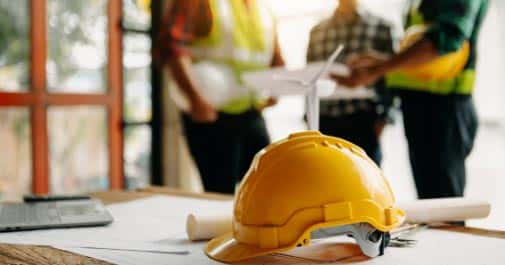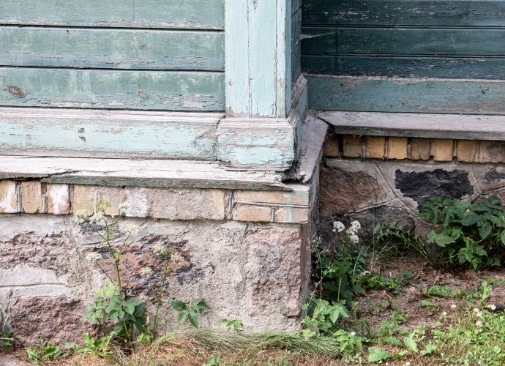Kansas City’s Best Foundation Pier Installation
The professional foundation repair contractors from Foundation 1 are the best when it comes to installing foundation piers in Kansas City. With years of experience and a commitment to using the highest grade materials, they ensure that any job we do is top notch. They take their time to inspect and measure every house, making sure the depth of the piers is correct for the soil type and structure of each particular home.
Once installed, the piers will help strengthen the foundation, prevent further settling, and provide better support for your property. If you live in or around Kansas City and need a foundation pier installation, contact Foundation 1 right away!
Our Foundation Pier Installation Process
At Foundation 1, our foundation pier installation process is designed for safe, proper support that will last for years to come.

Inspection
The foundation piering process always starts with a thorough inspection. Our team of experts carefully examines your property to detect any signs of foundation failure and determine the root cause of the problem.

Jobsite Preparation
Once we have identified the issue, we prepare the job site by setting up the equipment needed to install the Helical Piers.

Pier Installation
Unlike Push Piers that are pushed into the ground, Helical Piers are screwed into the soil to reach the load-bearing layer.
Lifting and Stabilization
After the foundation is prepped and Helical Piers are installed, we move on to the lifting and stabilization process. This will ensure that your home’s foundation is restored to its original level and stabilized to prevent further damage.
Final Inspection and Walkthrough
Finally, we’ll take you on a walkthrough to ensure everything meets your satisfaction. Our comprehensive installation process guarantees your home’s foundation is in good hands.
Call us today to learn more of what sets our foundation pier installation process apart.
Common warning signs that you may need Foundation Piers:
In the world of home ownership, foundation issues can be a nightmare. Early warning signs may seem like small problems, but they can indicate something greater is at play.
- Windows and doors that stick and are difficult to open and close
- The noticeable sinking of one or more sides of the home
- The chimney is tilting or pulling away from the home
- Interior and exterior cracks form
The longer you wait to get the problem taken care of, the more likely it becomes that the structural integrity of your family’s home will be jeopardized, creating a dangerous living situation.

Fix Foundation Settling With Foundation Piers
To take care of the problem, we make use of the Stratos Pier Piering System in Kansas City. Piers are pushed deep within the earth into bedrock or stable, load-bearing strata. The pier foundation will be able to stabilize, level, and lift the home back up to where it needs to be. Installation is fast with minimal excavation required.
Please note that the piers must be driven deep enough to hit bedrock or other stable strata, in order to be effective. This serves as the strong base needed to support the piers, which in turn support the foundation. If done correctly, however, piering is the strongest and most dependable method of stabilizing a foundation that is settling or sinking.
- Installed directly under the Load
- Interior or Exterior Installation
- Unique Interlocking, High Strength Steel
- No Brackets, No Bolts, No Breaking the Footing
- No Offset Load
Click here to view photos of recent foundation pier projects in Kansas City.
Foundation Piering FAQ
What are the warning signs to indicate the home might be settling in Kansas City?
Helical, or push piers, are used when your home is experiencing settlement, or even more specifically, differential settlement, meaning some parts of your home are sinking faster than others. Vertical cracks (up and down) are often the biggest indicator that your foundation is settling. These cracks will appear both inside and outside on foundation walls, and also in drywall throughout the home.
How do you determine if we need piers?
A great first step is to call us to send out an evaluator. The process they use to determine this is to use a laser to measure if the home has settled. The laser is set to level and we measure to the bottom of the ceiling or floor joists to identify differential levels. This process is the most scientific way to identify home settlement, and will show the evaluator which parts of your foundation need steel or concrete piers and which do not.
How do you determine how many piers we might need?
We use an “on center” guide, which is basically every 6 feet. Generally, then, a 24 foot wall would require 5 push piers. There are other factors which impact this, such as home weight, how much lift is required, if pivot piers are necessary (depending on lifting goal and wall layout), etc. However, this will give you some guidance. The goal with the “on center” approach is to stabilize or lift the wall with a sufficient level of support throughout the length of the wall between the push piers.
What factors impact if you can lift a home with piers?
Here we make the distinction between stabilizing a home (preventing additional settling/sinking) and lifting the home (lifting some parts of the home up to their original, or closer to their original position).
We view stabilization as a successful project, as some homes are not able to be lifted. Preventing the home from sinking further is an important victory for the homeowner.
Lifting, however, can be achieved in the majority of settings. In this case, the installation team will set up lasers (very similarly to how the evaluator identified where push piering was necessary) and a goal lift will be identified and monitored throughout the lift. The foundation repair team uses a series of tapes, with starting points identified and targeted points identified. As the home lifts, the team will monitor the laser levels in relation to the starting and targeted lift lines.
What impacts this is how much the home must be lifted, if lifting in one area creates any specific issues in other areas, and how easily the home is lifting. These things can only be identified at the time of installation. Often it is beneficial for the homeowner to be present during the lift so they can provide input. Our teams are expert at recommending either helical or push piers for lifting Kansas City foundations and will be able to provide real-time feedback on the issues they are looking at and/or are concerned with.
Stabilizing and lifting gets your home back into a more natural position, in addition to preventing further sinking.
Lifting vs. Stabilization is an interesting question and should be discussed both with your evaluator, as well as the installation team working on your home.
Are your piers able to support my home?
Our piers have been subject to some of the most extensive testing in the industry and meet ANSI standards. A structural engineering analysis of the piers has concluded the piers are appropriate for residential and light commercial applications. Each pier has been determined to support 28,000 pounds in engineering tests which replicate actual use settings.
Can lifting my house impact other parts of the home?
Yes, it can. Just as your home sinking can cause cracks and doors to stick throughout the home, modifying the home’s structure can impact these things as well. Very often, if cracks have resulted from the settling, when we stabilize / lift, these cracks will close. If cracks have been cosmetically fixed during the time the house was settling, cracks could reappear, as the “closed crack” was being supported by a sinking foundation. If renovations have been made after the home has settled, lifting the foundation can have an impact as the settlement is corrected.
This impact on other parts of the house is a key consideration for our team when stabilizing and / or lifting. Monitoring how the home is reacting to changing (improving) its structural support is important.
It is key to remember that your home may have settled over the course of months, years, and even decades. When we stabilize and lift the home in a matter of hours it can create impacts throughout the home.
The good news is that once the home is stabilized, you will eliminate these kinds of worries and concerns going forward. We work closely with you to ensure our project most benefits you and your home.
Why are your piers better than the competition?
There are a number of reasons. Some are very basic and some are more complicated. First, a quick look at our push pier will show that we use a thicker metal than other push piers in Kansas City. We also use USA steel for the key load bearing sections, where some other piers are fabricated with foreign steel. Our pier also uses a concentric design which places the contact point of the pier directly under the home and above the pier; other piers attach to the side of the home and do not put the weight of the home directly under the pier. Our pier does NOT require chipping, cutting, or bolting into your foundation, which can weaken the foundation footing; others do. Lastly, the Impact Piering System uses a contact mechanism which allows for up to 8 degrees of variability in the footing without impacting pier performance; many piers on the market rely on a perfectly flat footing to ensure maximal contact between the home and the pier, which is often not the case.
Is there engineering support for your piers?
Yes, there is. The pier was developed in conjunction with a structural engineer. And the pier was subjected to extensive engineering testing, which it passed. The testing protocol used meets with ANSI standards. The engineering data (which is available upon request) indicates the pier is sufficient to support residential homes and light commercial applications.
What is the difference between a push pier and helical piers?
A push pier is hydraulically driven into the earth using the home’s weight as a counter. Helical piers are rotated into the soil in a matter similar to screws.
While both piers are used by Foundation 1 and have application in different settings, Foundation 1 tends to rely on push piers in residential repair settings as a superior alternative and in settings where is in place to use to drive foundation piers. Generally, this means we prefer push piers (Impact Piering System) in repair settings. In new construction and certain industrial applications in Kansas City, helical piers are the preferred choice, often because the weight of the structure is not available to drive push piers.
This, too, is a great question to bring up with your evaluator when they are looking at your home and designing a repair plan for your property.
What is the difference between interior and exterior piers?
Piers can be installed both from outside of the home, as well as the inside. In both cases, we will be extremely cautious to minimize the impact on landscaping or interiors. Your evaluator will consider these factors in the design plan. In addition to minimizing impact on surroundings, the goal of the pier will be considered. (Some piers must be installed inside vs. outside, etc. and vice versa.)
Is there a warranty?
See your bid / contract for specifics on your project, but generally, yes! Both Foundation 1, as the installer, and our pier manufacturers offer lifetime warranties on helical and push piers in Kansas City.
